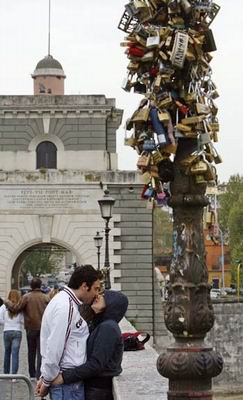Lampposts on Rome’s Ponte Milvio Bridge Nearly Collapse from Locks of LoveRemember that feeling of wanting to tell the entire world how much your new or existing love means to you? (I hope that feeling is still true for you!) I carved my first "real" girlfriends name plus mine in a giant old tree trunk at grandma’s farmhouse when I was fifteen, and it remained as a testament to that giddiness many years after we parted ways. And toward the beginning of my relationship with my wife, when we were first dating, I carved "Brian + Beth" in the wood of an old bridge known for such etchings in a park in Sycamore, Illinois, where I believe it still remains as a testament of our love today. But while etching notes of love on walls, trees, and bridges has been in vogue for eons -- "Marcus loves Spendusa" is among the ancient graffiti on the preserved walls of Pompeii -- a new vogue has hit Rome, Italy involving padlocks and the famous Ponte Milvio Bridge.
The Story Behind The Ponte Milvio Bridge Love Ritual The Ponte Milvio is the oldest and one of the most important bridges over the Tiber in Rome. Built in 206 B.C., the bridge had always attracted lovers. In fact, the first-century Roman historian and statesman, Tacitus, reported that in his time Ponte Milvio was “famous for its nocturnal attractions.” He even claims that Emperor Nero visited the famous bridge “for his debaucheries.” In 2006, a new trend began on the Ponte Milvio. The trend started as a result of the second episode of a story of young Romans called I Want You written by Federico Moccia. In the story, Moccia’s hero convinces a potential girlfriend that a legend he made up is actually true. In that legend, lovers wrap a lock and chain with their names on it around the third lamppost on the Ponte Milvio Bridge’s northern side. They lock it and throw the key into the Tiber river. That act, according to his invented legend, ensures eternal love. After Moccia's story gained momentum, many couples actually started hanging padlocks with their names on it on a lamppost on the bridge, throwing the key behind them into the Tiber. Love Comes Down
Since Moccia's story came out, thousands of locks and chains have appeared on the bridge’s lampposts. On April 13, 2007, officials stepped in and condemned the practice as vandalism; the lampposts had partially collapsed because of the weight of all the padlocks. Many people were upset and accused the officials of being anti-love. Officials acquiesced with a better solution: posts were installed on the bridges onto which couples could safely hang their padlocks for all to see. Within days of the posts going up, many more new "love locks" have been sealed shut on Ponte Milvio. But while couples can pretend their lock will be there forever, just as the city sweeps the coins periodically from fountains, the locks will be removed periodically as well. Only time will tell if love will endure after the padlocks are gone. Alternately, lovers can go to a website to place virtual locks on a virtual version of the Ponte Milvio Bridge, but somehow that just doesn't seem as romantic.
|

